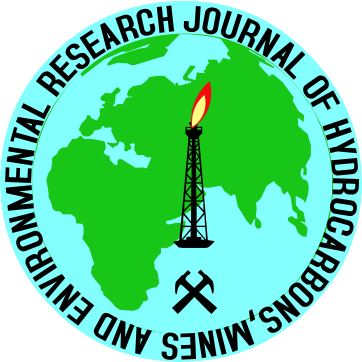JOURNAL OF HYDROCARBONS MINES
AND ENVIRONMENTAL RESEARCH
__________________
 |
©
Journal of Hydrocarbons Mines and Environmental Research, ISSN: 2107-6510,
Volume 5, Issue 1, June 2014, 28-45 __________________________________________________________________________________________________ |
Sur les réservoirs potentiels crétacés-miocènes
en offshore du golfe de Hammamet par sismique et corrélations lithostratigraphiques
Imed Hezzi 1,2,*, Tahar Aïfa 1 and Mohamed Ghanmi
2
1 Géosciences-Rennes, CNRS UMR6118, Université de Rennes 1,
Bat.15, Campus de Beaulieu, 35042, Rennes cedex, France
2 Département de Géologie, Faculté des Sciences, Université de
Tunis El Manar, 2092 El Manar II, Tunis, Tunisia
*corresponding author : hezzimed@yahoo.fr (I. Hezzi)
Received: 21 February 2014 - Accepted: 24 March 2014 - Available online: 24 March 2014
Résumé: L’interprétation
des profils sismiques, des cartes isobathes et des corrélations
lithostratigraphiques des puits pétroliers dans le golfe de Hammamet
montrent des lacunes d’érosion ou de non dépôt
fréquentes, des discontinuités, des variations latérales
d’épaisseur et de faciès, des biseaux et des discordances
des séries sédimentaires du Crétacé au Miocène.
Le golfe de Hammamet correspond à une plateforme dominée
par des zones hautes sous forme de plis et de blocs basculés qui
sont induites par une tectonique polyphasée crétacé-miocène
et plio-quaternaire. Celle-ci a engendré des mouvements d’instabilité du
plancher sédimentaire par la réactivation d’anciennes
discontinuités, pouvant être enracinées dans le socle.
Les phases compressives NW-SE associées à cette tectonique,
d’âge Maastrichtien-Danien, Yprésien-Priabonien (phase
alpine), se caractérisent par des structures plissées et
l’inversion d’anciennes failles normales. Elles ont créé d’importants
espaces disponibles pour faciliter la sédimentation des séries
miocènes. Les dernières phases transpressives NW-SE au Tortonien (phase
atlasique) et au Plio-Quaternaire ont aussi engendré des structures
plissées à axes NE-SW et des inversions de bassins. Ces phases
alpine et atlasique s’amortissent vers l’Est lors de la transition
onshore-offshore et leur ampleur augmente vers l’Ouest et le Nord-Ouest
où l’on observe des zones fortement faillées et plissées,
alors que vers l’Est, les zones sont faillées et structurées
en horsts et en grabens. Tandis que les phases transtensives NE-SW se sont
produites surtout au Serravallien supérieur-Tortonien inférieur
et Messinien-Gélasien en créant des bassins en pull-apart.
Pendant ces périodes transtensives se sont développés
des bassins subsidents en grabens, demi-grabens, et des blocs basculés
donnant lieu à des émergences de paléostructures.
La variation latérale et l’alternance en profondeur et en
faciès des séries peuvent contribuer à la formation
de réservoirs carbonatées et siliciclastiques pour l’accumulation
des hydrocarbures. Les pièges, observés sur les lignes sismiques
interprétées, se forment au contact des failles ou en biseau
par discordance ou hiatus soit par l’intercalation de sédiments
poreux et perméables sous contrôle de l’eustatisme,
la tectonique et/ou la sédimentation.
Les contraintes mises en jeu
ont créé un système de fractures et ont ainsi contribué à augmenter
l’interconnexion entre pores/fractures dans les réservoirs.
Elles ont permis la migration des hydrocarbures de la roche mère
(Serdj, Bou Dabbous-El Gueria) vers les réservoirs et ont amélioré ainsi
leur qualité, en particulier dans les formations Fahdène/Aleg,
Bahloul, Abiod, Bou Dabbous, Fortuna/Ketatna, Aïn Grab, Birsa, Saouaf.
Mots clés: Golfe
de Hammamet, Crétacé-Miocène, transpression, sismique,
inversion, réservoir.
On the Cretaceous-Miocene potential reservoirs offshore the gulf of Hammamet using seismics and lithostratigraphic correlations
Abstract: The interpretation
of the seismic profiles, the isobath maps and the lithostratigraphic correlations
of the oil wells in the gulf of Hammamet show gaps of frequent erosion
or non-deposit, discontinuities, lateral and thickness variations of facies,
bevels and unconformities of the Cretaceous-Miocene sedimentary sequences.
The gulf of Hammamet corresponds to a platform dominated by highs
in the shape of folds and of blocks titled induced by polyphased Cretaceous-Quaternary
tectonics. This one generated instability movements of the sedimentary
floor by the reactivation of old faults, probably rooted in the basement.
Compressive phases NW-SE associated with this tectonics, Maastrichtian-Danian,
Ypresian-Priabonian in age (Alpine phase), are characterized by folded
structures and inversion of old normal faults. They created important spaces
available to facilitate the sedimentation of the Miocene series. The last
transpressional phases NW-SE during the Tortonian (Atlassic phase)
and the Plio-Quaternary also generated folded structures along with NE-SW
axes and inversions of basins. These Alpine and Atlassic phases depreciate
towards the East at the onshore-offshore transition and their intensity
increases westwards and northwestwards where strongly faulted and folded
zones are observed, whereas eastwards, the faulted zones are structured
in horsts and grabens. While the NE-SW transtensional phases occurred especially
during the Upper Serravallian-Lower Tortonian and Messinian-Gelasian, creating
pull-apart basins. For these periods subsident basins developed in grabens,
half-grabens, and tilted blocks causing emergences of paleostructures.
Alternation of the series may contribute to the formation of carbonated
and siliciclastic reservoirs for the accumulation of hydrocarbons. The
traps, observed on the interpreted seismic lines, are formed in contact
with faults or in bevel by unconformity or hiatus either through intercalation
of porous and permeable sediments under control of the eustatism, tectonics
and/or sedimentation.
The concerned stress regime created a system of fractures and thus contributed to
increase the interconnection between pores/fractures in the reservoirs.
They allowed the migration of hydrocarbons from the bed rock (Serdj, Bou
Dabbous-El Gueria) towards the reservoirs and thus the increase of their
quality, especially in the Fahdène/Aleg, Bahloul, Abiod, Bou Dabbous,
Fortuna/Ketatna, Aïn Grab, Birsa, and Saouaf formations
Keywords: Gulf of Hammamet, Cretaceous-Miocene,
transpression, seismics, inversion, reservoir.